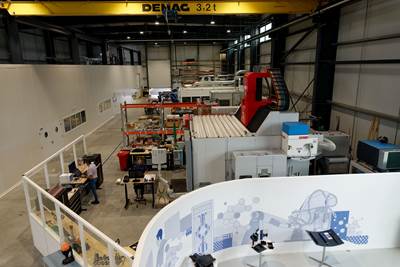A reflection on industrial tourism
Composites industry insights gleaned from spending time on the road.

The custom fiber sizing line at IACMI’s new Innovation South facility in Knoxville, Tennessee, was contributed by Michelman. Source (All Images) | CW
I was recently talking to someone I met over lunch at the SAMPE Summit in Paris about the various facility tours that CW editors endeavor to piggyback onto our travels. “Industrial tourism,” she called it, as we chatted about the melding of manufacturing facility visits and sightseeing opportunities. It was a perfect way to sum up the past few weeks.
In late February, CW visited the Institute for Advanced Composites Manufacturing Innovation (IACMI) in Knoxville, Tennessee, to attend an open house showcasing the institute’s new Innovation South facility. The brainchild of IACMI CTO Uday Vaidya, the new facility brings together, under one roof, many of IACMI’s various capabilities including compression molding, filament winding, automated tape placement and a new 70-foot custom fiber sizing line contributed by Michelman (Cincinnati, Ohio, U.S.). In partnership with the University of Tennessee and Oak Ridge National Laboratory (ORNL), IACMI’s Innovation South facility offers a great resource for workforce development and startup companies in the composites sector.
In true industrial tourism fashion, CW also toured the new Magnum Venus Products (MVP) facility, also located in Knoxville. The 125,000-square-foot facility has helped boost the company’s production capacity by 25% and includes an expanded technical service center, new inventory management systems and dedicated spaces for R&D. We also visited research and product development company Carbon Rivers to learn about the work the company is doing with reclaimed glass fiber from decommissioned wind blades, as well as its R&D work with graphene.
Shortly after visiting Knoxville, I embarked on a trip to Germany to visit a handful of composites facilities prior to heading to Paris for JEC World in early March. The journey — starting at Voith HySTech in Garching and then moving on to the University of Augsburg to visit AI Production Network and the DLR Centre for Lightweight Production Technology (ZLP) — was a reminder of the irreplaceable value of being on the ground, seeing technology firsthand and engaging in face-to-face discussions with industry leaders.

Tow winding machine at Voith HySTech.
Voith HySTech’s work in high-speed production of hydrogen storage systems underscores a key theme in composites today: sustainability paired with scalability. As industries from automotive to aerospace seek greener solutions, composites manufacturers are under pressure to deliver materials and processes (M&P) that balance performance, cost and environmental impact. Seeing this work in progress in person reinforces how critical, real-world applications are in moving beyond theoretical solutions. Meanwhile, the AI Production Network is dedicated to exploring ways that artificial intelligence and machine learning can be used to find efficiencies and ultimately enable scalability. At DLR ZLP, the focus on automated fiber placement, out-of-autoclave processing and welding technologies for thermoplastic composites is reshaping how we approach high-performance structures. The ability to see these technologies in action, and to ask engineers directly about challenges and breakthroughs brings a level of insight that no webinar or white paper can match.
For me, this month’s travels culminated at JEC World, where you can truly feel the pulse of the industry. Nothing compares to the energy of thousands of professionals from countries spanning the globe all exchanging ideas under one roof. Composites manufacturing is a global industry, with a range of priorities across regions from geopolitical pressures to varying market demands and resources. Experiencing these differing viewpoints firsthand makes it clear that no single region has all the answers — but by working together as an industry, we can collectively move the needle.
As we look ahead, the industry’s biggest challenges — achieving circularity, improving LCA and more sustainable M&P and enabling more resilient supply chains — will not be solved in isolation. The path forward will require collaboration across borders, sectors and disciplines. And while digital tools help keep us connected, nothing replaces the power of in-person engagement.
Related Content
Who's ready for the Olympics?
With the 2024 Summer Olympics in Paris, this year’s JEC World is bound to be abuzz with talk of this year’s event — from the use of composites in sporting equipment to the roles they play in AAM.
Read MoreThe (not exactly) new guy at CW
Former CW writer and editor Scott Francis rejoins the brand as editor-in-chief as Jeff Sloan assumes the role of publisher.
Read MoreComposites trends of 2024: Innovating for a sustainable, high-rate future
CW's annual look back over the last year reviews the technologies, processes and sustainability initiatives still shaping the composites industry.
Read MoreAchieving composites innovation through collaboration
Stephen Heinz, vice president of R&I for Syensqo delivered an inspirational keynote at SAMPE 2024, highlighting the significant role of composite materials in emerging technologies and encouraging broader collaboration within the manufacturing community.
Read MoreRead Next
What’s top of mind in composites?
As the composites industry gathers for its largest international trade show, CW’s editorial team shares the key trends and challenges they’re tracking — from aerospace innovations and recycling advancements to economic shifts and the future of eVTOL.
Read MoreAssembling the Multifunctional Fuselage Demonstrator: The final welds
Building the all-thermoplastic composite fuselage demonstrator comes to an end with continuous ultrasonic welding of the RH longitudinal fuselage joint and resistance welding for coupling of the fuselage frames across the upper and lower halves.
Read MorePlant tour: Daher Shap’in TechCenter and composites production plant, Saint-Aignan-de-Grandlieu, France
Co-located R&D and production advance OOA thermosets, thermoplastics, welding, recycling and digital technologies for faster processing and certification of lighter, more sustainable composites.
Read More






















